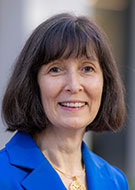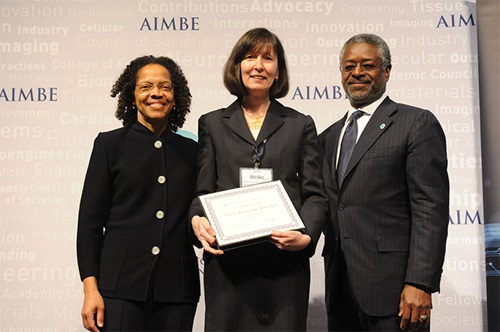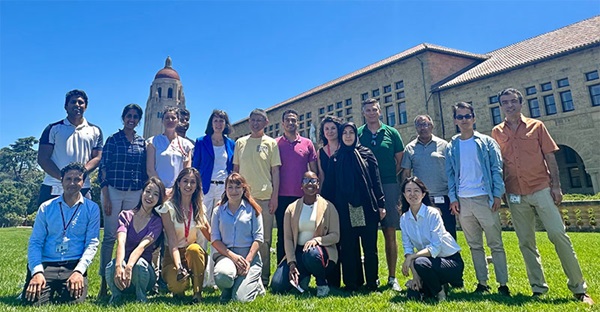RSNA Member Spotlight: Heike Elisabeth Daldrup-Link, MD, PhD
Learn more about a fellow RSNA member

Heike Elisabeth Daldrup-Link, MD, PhD, is a tenured professor of radiology at Stanford University in California. She is also director of the Pediatric Molecular Imaging Program in the Department of Radiology and co-director of the Cancer Imaging Program at the Stanford Cancer Institute.
An elected member of the American Society for Clinical Investigation (ASCI), an honor society for clinician-scientists, Dr. Daldrup-Link is also fellow-elect of the World Molecular Imaging Society (WMIS) and an elected member of the American Institute of Medical and Biological Engineering (AIMBE), an organization that welcomes only the top 2% of medical and biological engineers in the United States.

Dr. Daldrup-Link received her MD degree from the University of Münster, Germany, in 1993, and her PD (“Privatdozent”) degree from the Technical University in Munich, in 2003 (with PhD equivalence certification from the Center for Educational Documentation Inc., in Boston). She completed a postdoctoral research fellowship at the University of California, San Francisco (UCSF), radiology residency at the University of Münster and the Technical University of Munich, and a fellowship in pediatric radiology at Schwabing Children’s Hospital of the Technical University of Munich.
In 2003, Dr. Daldrup-Link became an assistant professor of radiology at UCSF and was recruited to Stanford in 2010.
As a physician-scientist, Dr. Daldrup-Link uncovered basic science principles in a National Institutes of Health (NIH)-funded basic science lab and has brought promising medical imaging innovations to her patients' bedside. A prolific author, Dr. Daldrup-Link has published over 200 peer-reviewed research articles with 16,170 citations, 68 review articles, book chapters and editorials, ten books and seven patents.
Apart from her work as a clinical radiologist and scientist, Dr. Daldrup-Link actively promotes the diversification of the biomedical workforce through advocacy and mentorship. She is widely known for her powerful reflections and opinion pieces on women in STEM and she serves as managing director of Monasteria Press LLC, a publishing company that advances STEM education through storytelling.

What or who sparked your interest in radiology?
When I was a medical student, I initially wanted to become a pediatrician. However, a friend introduced me to MRI, leading me to pursue an MD thesis under Dr. Ernst Rummeny on MRI of liver tumors with novel contrast agents. It was a brand-new technology at the time. Concurrently, I met my future husband, Dr. Thomas Link, a radiology resident. Inspired by these experiences, I successfully applied for radiology residency and specialized in pediatric radiology, combining my childhood dream of working with children with a career in medical imaging.
What has been your best professional accomplishment?
As a physician, I am devoted to serving my patients. Over the years, I have developed a specialized role as the primary radiologist for our pediatric oncology team. Collaborating closely with pediatric oncologists, I find immense satisfaction in contributing to precise diagnoses and positive outcomes of children with cancer.
As a physician-scientist, I investigate novel imaging techniques for the benefit of children with cancer and am proud that our team translated many of these from the bench to the bedside, creating direct value for our patients. I am grateful for the NIH, many foundations and Stanford University for supporting my research work. A specific highlight for me here was my induction into the American Institute of Medical and Biological Engineering (AIMBE) at the Academy of Sciences in Washington, DC. The RSNA R&E Foundation supported my work as a junior researcher and since then, my husband and I have donated to the Foundation every year to facilitate similar paths for others.
As a mentor, I feel blessed to work with a team of incredibly bright and talented trainees and I feel proud to see my team members evolve into confident researchers and/or physician-scientists who achieve extraordinary results. Over the past 20 years, members of my team have achieved 88 honors and awards for research work in my lab. Many alumni of my lab are leading scientists, clinicians and entrepreneurs in North America and around the world today.
What has been the biggest challenge you have faced in building your career?
First, let me say that challenges are an inevitable part of any professional journey. In fact, they can be catalysts for growth and innovation. While it's essential to smooth the way for future generations as best as possible, I believe facing and overcoming obstacles is a fundamental aspect of personal and professional growth. Sometimes, the toughest experiences teach us the most valuable lessons, redirecting our paths in unexpected yet rewarding directions.
There are many challenges that radiologists—and female radiologists specifically—have to overcome to launch a successful career. What is or was the biggest challenge for me? Perhaps that is always the challenge I have in front of me at any given moment. I do not really “grade” challenges. Instead, I identify obstacles that I can overcome and barriers that necessitate a new direction.
Over the past two decades of my career, I encountered challenges due to high workload, intricate office dynamics, limited leadership opportunities, gender disparities and many others. To help others navigating different scenarios, I wrote a guide to navigating workplace challenges in academia.

What RSNA resources do you use to assist with professional development and in your daily practice?
I like to read the Radiology journals, including the main journal, Radiology: Imaging Cancer and Radiology: AI. They provide me with a great update about new developments in the field.
I also found the RSNA educator resources very helpful, especially the interactive learning modules. I sometimes refer our clinical colleagues, parents and/or patients to the Radiology Info for Kids website:
When you’re not working, how do you like to spend your free time?
My husband and I enjoy spending time with our family and friends. I like to bake and cook, and we regularly host dinner parties in our home. I wrote a baking book some time ago and am always thrilled when my guests enjoy the latest recipe.
California's incredible natural beauty is our backyard. We highly enjoy living in the San Francisco Bay area and regularly go on hiking trips. Whether we're strolling along the beach or conquering a challenging trail in the mountains, we're always up for an adventure.
I also started a hobby as a creative writer under the pen name Elisabeth Link. I participated in a fellowship program of the Stanford Humanities program where I received formal training in creative writing and wrote several medical mystery novels, including a mystery novel that teaches the diagnosis of bone fractures on X-rays.
For More Information
Find Dr. Daldrup-Link on social media:
- LinkedIn: www.linkedin.com/in/heike-daldrup-link-04089846/
- X: @PedsMIPS
- Instagram: @monasteria_press
Keep up to date with RSNA member achievements, moves and news by visiting RSNA.org/News/Announcements/Member-Updates.
Access some of Dr. Daldrup-Link's publications:
Access some of Dr. Daldrup-Link’s publications:
- “Heal & Thrive: A Guide to Navigating Workplace Challenges in Academia”
- “San Francisco Bay Area Baking Book,”
- “The Stolen Brain Chip: A Tale for Healthcare Professionals”
- “The Claim: A Medical Mystery”
- “The Fermi Paradox in STEM—Where Are the Women Leaders?”
- “Who Killed Nia Johnes?: A Medical Mystery”
- Monasteria Press
Read the Stanford Medicine Scope blog post about Dr. Daldrup-Link’s mystery novel.